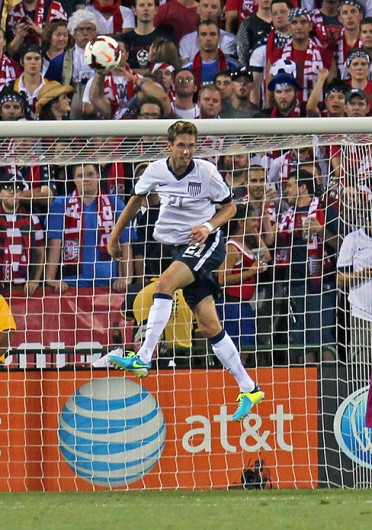
United States Men’s National Team defender Clarence Goodson (21) heads the ball away from goal during a World Cup Qualifying match against Mexico Sept. 10 at Crew Stadium. The USMNT won, 2-0.
Credit: Shelby Lum / Photo editor
For months, my mind has been singularly focused on this year’s FIFA World Cup. Ever since the calendar turned to 2014 it’s seemed so close, but in truth it’s always been comfortably out of reach. That situation has changed, however, and the world’s greatest sporting event is now right around the corner.
The first event announcing that the tournament is imminent – the World Cup herald, if you will – is the naming of the rosters. Competing nations had until Tuesday to name a provisional squad of 30 players to take to a pre-tournament training camp. Each country has until June 2 to provide FIFA with a final list of 23 players whom it will take to Brazil.
Some countries – England, Brazil, Mexico and others – elect to skip the 30-man squad and go straight to the 23. But a majority of the nations still name preliminary squads.
One of those countries to name its 30 players this week: the United States.
Head coach Jurgen Klinsmann revealed his selection of players on Monday, and while the names didn’t cause shock among the American soccer public, the omission of striker Eddie Johnson did raise a few eyebrows.
Johnson scored the winning goal in the U.S.’s 2-0 victory over Mexico on Sept. 10 at Columbus Crew Stadium. Even though his goal effectively clinched World Cup qualification, Johnson’s failure to score in his first eight games of the season with D.C. United is probably the reason Klinsmann decided against selecting him.
There’s a very good chance that Columbus will be represented in Brazil with Crew captain Michael Parkhurst included in the preliminary roster. Parkhurst may have been on the outside looking in a year ago, but his performances since then for the national team have been exemplary, and I’d be very surprised if he didn’t wind up with a seat on the plane to South America.
Other than that, the squad picks itself – meaning the real test will be seeing who makes the final 23. In my opinion, there are roughly 20 “locks,” while the final three spots will be decided over the coming weeks.
The team will gather for the first time on Wednesday at Stanford University. Once there, they’ll participate in a training camp and ultimately compete in three friendlies: against Azerbaijan on May 27 in San Francisco, against Turkey on June 1 in Harrison, N.J., and then with the final roster against Nigeria on June 7 in Jacksonville, Fla.
The prize awaiting the players who make the cut? A shot at playing against some of the best players in the world during games against Ghana, Portugal and Germany in the opening round at the World Cup.
I’d argue that the U.S. has one of the most talented squads in its history, with an array of talent from the goalkeeping position all the way to the forward line. It may not include a world superstar, but then that isn’t a prerequisite to succeeding in a World Cup – just ask Argentina forward Lionel Messi.
The doubters will rightly point to the standard of opposition, a group that deserves it’s moniker as the “group of death.” Germany and Ghana have both overcome the U.S. twice in World Cup play, while Portugal fell to the Americans in 2002 with arguably the most disappointing squad in its history. Thank goodness this year’s World Cup isn’t being played in Panem, because the odds certainly aren’t in the U.S.’s favor.
But having said that, I don’t see why many are so quick in writing off the U.S. team’s chances.
For starters, having a tough group at the World Cup shouldn’t be a blow to morale. It should be expected. After all, the competition isn’t held in high esteem for nothing. It takes the best teams on the planet and puts them in one place to find an eventual winner.
In 2010, it could be argued that the U.S. was handed an “easy” draw against England, Slovenia and Algeria. Even though the Americans navigated that group successfully, it’s not like it came easy. If you’re hoping to face a second-rate, low-quality side at the World Cup, you’ve come to the wrong place.
That’s why I think the prospect of facing these talented countries shouldn’t be seen as a doomed exercise. Instead, it should be recognized as a tremendous opportunity to showcase just how far soccer in this country has come since the days when barely any matches were shown on television. The world’s best teams become the world’s best teams because they overcome difficult opposition, and that’s the only way the U.S. is going to move up world soccer’s ladder.
The U.S. has never made it out of the group stage in consecutive tournaments, and if that trend continues it won’t necessarily signal a failure, but more of an indication that the national team’s growth still has a long way to go.
But if it can reverse that trend, and bury the demons of the past three World Cups against the countries that eliminated them, it will be an epoch-defining achievement.
Believing in an outcome like that sounds a lot more fun to me than dismissing the national team’s efforts before they even begin.
If you want a place on the bandwagon there’s still time. We’ve got plenty of room.


